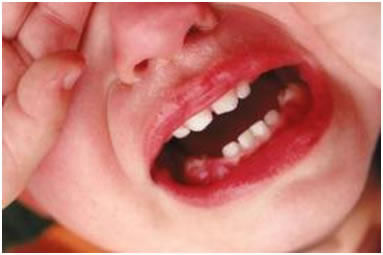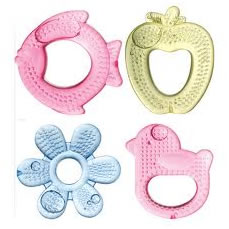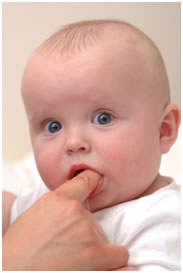How to Cope When Teething Starts

Teething Timeline
The average baby will have the arrival of his or her first tooth around six months of age. But just as your baby will hit other milestones at his or her own pace, so too will teeth come on their own timeline. While six months is the average, there is a wide range of ages for that first tooth to appear. Though rare, some infants may be born with one or even two teeth, while others' teeth take well over a year to show up. Typically, the two bottom-front teeth will appear first, progressing until the second molars arrive, usually between 2 to 2.5 years old. Typically by two-and-a-half, most children have all of their baby teeth in, which is about 20 teeth.
Although teething is different for each baby, with the pain level and length of time it takes for a tooth to make its appearance varied, many parents recognize the 6 following signs:
- Irritability
- Biting and gnawing
- Gum swelling
- Chin rash
- Disrupted sleeping pattern
- Cold-like symptoms, drooling, diarrhea, or low-grade fever - Although these teething symptoms are up for debate, some swear that these symptoms are a sign of teeth to come. However, if any symptoms are paired with a high fever or other signs of illness, contact your pediatrician for his or her opinion.
But while some kids do experience discomfort with teething, there are children who aren't bothered by the process. There are a lot of children where the parents will oftentimes not even realize that they're teething at all. It just varies from child to child as to what symptoms they might have or if they even have any symptoms of teething. Some parents start expecting teeth once that signature drooling begins, but drooling can start months before the first tooth arrives. Because teething is a process, teeth don't arrive all of a sudden. Instead, teeth push their way through in starts and stops.
How to Ease Discomfort
Although the first teeth typically appear during infancy, the teething pain train doesn’t stop there. “From ages six-months to three years, children may have tender gums when teeth begin to grow in,” says John R. Liu, DDS, President of the American Academy of Pediatric Dentistry. There are several options available to ease the teething pain.
- “The American Academy of Pediatric Dentistry (AAPD) recommends parents use a clean teething ring, a chilled teething ring or cold wet washcloth for teething babies,” advises Dr. Liu. Wet the cloth, squeeze out the excess water, and throw it in a baggie in the refrigerator or freezer. The chill from the rag as the baby chews on it will help relieve the irritation. Also, be careful that the baby is chewing on age-appropriate items without small parts that could be choking hazards.
- Chilled pacifier - Similar to a chilled teething ring, stock the fridge or freezer with binkies and swap them out when teething discomfort makes an appearance.
 Gum massage – Massaging his inflamed gums with your clean finger may be just what the doctor ordered to counteract the pressure from the tooth below.
Gum massage – Massaging his inflamed gums with your clean finger may be just what the doctor ordered to counteract the pressure from the tooth below. - Cold foods – For the youngest teethers, mesh baby-safe feeders filled with age-appropriate frozen fruit can offer relief without the risk of choking. If your tot is old enough, cold foods like ice pop may soothe sore gums.
- Over-the-counter medicine - Baby Tylenol or Motrin (check with a pediatrician for the correct dosage), may give your baby the relief he needs to get some rest when teething pain prevails. The American Academy of Pediatrics states that medications that you rub on the gums are not necessary or useful because they wash out of the baby's mouth within minutes-and some can be harmful if overused and your baby swallows too much.
- Acupressure - "Massage your baby's toes, paying extra attention to joints of the toes,” offers Monika Benoit BA, CH, HHP, Holistic Health Practitioner. “According to acupressure theory, this stimulates energy meridians that directly connect to the mouth and teeth, providing drug-free pain relief for your baby's sore gums."
Once those teeth are in, parents must start thinking about dental care if they haven't already done so. Even though baby teeth won't be around forever, parents should instill good dental habits in their kids from an early age.
Even before teeth come in, parents start getting into habit of wiping the child's mouth after feeding so that the child gets used to idea of getting their mouth cleaned. Simply take a burp cloth and wipe the gums and teeth. When more teeth arrive, using finger toothbrushes before transitioning to the smallest, softest toothbrush for babies. Even when your child is old enough to brush on his own, supervise the process to make sure the job is thorough and help with brushing. The American Academy of Pediatric Dentistry suggests children see the dentist by the time they're a year old. This instills the habit of frequent dentists visits at a early age and gives the dentist the opportunity to chat with parents about proper tooth care.
Sources
http://www.aapd.org/media/pediatricdentistryarticles.asp?NEWS_ID=1334
http://babyfit.sparkpeople.com/articles.asp?id=1046





